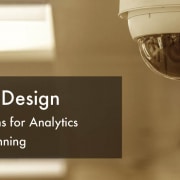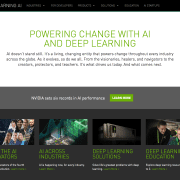Key Security Trends to Watch in 2022

A look into the year ahead in both market and customer trends for AI-powered video analytics.
Given that Ariel recently covered some of the more exciting advancements from a technology standpoint, I’m going to highlight four market and customer trends for AI-powered video intelligence that I see emerging in 2022. Based on the work we are doing with security and safety teams at 3 of the Fortune 10, we are seeing some very interesting trends coming to the surface:
Things are Looking ROSI
I see 2022 as a year when Return on Security Investment (ROSI) starts to become more common in the corporate lexicon. There are a couple drivers of this trend:
- First, the proliferation and digitization of physical security infrastructure over the past few years means security teams now oversee an increasingly valuable organizational asset: granular data coming off cameras and access control readers.
- Second, AI (and in particular deep learning) continues to unlock new ways (objects, events, actions) to make sense of the data and derive valuable insights from it.
- Third, security organizations, flush with data and ways to interpret it, are increasingly joining the API economy inside the enterprise, something Gartner has been keen on for a while.
Forward-thinking organizations have dedicated software developers on the security team that take data generated by the security infrastructure and feed it, via APIs, to other parts of the organization. This happens through business intelligence tools or directly into the applications those other departments use like HR software or real estate space planning software.
As the digital transformation of the security organization gains momentum, the AI literacy of security teams will take center stage in 2022.
So where does the “R” (Return) in ROSI actually come from in 2022? There are three sources of return we are seeing forward-thinking security teams tap into:
- First, in security operations, they are showing that they can scale to more (typically smaller, regional) locations with the same GSOC headcount by augmenting their staff with technology like video analytics.
- Second, identifying liabilities sooner, often in the field of environmental health and safety and compliance, provides a clear ROSI to the business. For example, we have one manufacturing customer using our technology to monitor and report on how many people are taking shortcuts through restricted areas and high risk areas at their site as demand for their product has soared in COVID. Each undetected incident can have price tags of hundreds of thousands of dollars if a workplace injury or compliance infraction occurs. Detecting these incidents and remediating behavior produces a return in terms of future liabilities avoided.
- Finally, real estate and facilities teams have a voracious appetite to understand when, where, and how their physical environments are being used. Space utilization, traffic flow and density will all be key inputs in 2022, as security teams can provide valuable data into designing and executing the “Next Normal” for how enterprises get work done.
With a smarter, more data-driven approach to their operations, security leaders can scale easier, better-mitigate potential issues and contribute to their organization’s bottom line, quickly earning a seat at the big table and generating a positive ROSI.
Privacy and Security Peacefully Co-Existing
If security and safety teams increasingly control key data coming from a multitude of powerful sensors, there will be an increased focus on how that data is used.
For example, when it comes to the use of biometric technology like face recognition, the pendulum has swung from a majority of organizations wanting to deploy it a few years ago to a much more cautious outlook today. We think 2022 will highlight a “Goldilocks moment” when a few things will drive organizations to find the right balance between individual privacy and collective security:
- First, the pendulum is swinging back towards a concern for collective security. From a physical assault and cyber assault standpoint, the workplace has never been risker, thus driving new conversations around tech with business leaders that can help prevent these expensive issues.
- Second, security teams are getting more experienced at internally marketing the benefits of their projects to the business. Rather than deploy technology in the shadows and risk it not being understood, they are doing it in the public and with increased transparency and benefit, including with emerging frameworks for security data governance.
- Third, security teams are bringing the data produced by the security infrastructure to the business user’s workflow rather than the other way around. For example, real estate and operations teams can get continuous access to anonymized occupancy data from cameras without needing to access the security system.
- Finally, the market has responded with flexible technology that can both be privacy-centric and security-minded. For example, our solutions at Vintra constantly log every operator action by design and enable biometrics to be shut off.
For many enterprise teams, these advancements strike the Goldilocks balance between privacy and security. While critical events will continue to occur, advancements in AI technology will allow for a well-needed balance of providing key situational data while protecting the rights of the employee.
AI Literacy Will Become Table Stakes
As the digital transformation of the security organization gains momentum, the AI literacy of security teams will take center stage in 2022. AI literacy is a set of competencies that enables individuals to critically evaluate AI technologies; communicate and collaborate effectively with AI; and use AI as a tool in the workplace.
Looking across our customer base, I see some common approaches forward-thinking teams are taking to grow their AI literacy:
- First, security teams are demanding technology that is purpose built for performance in their application. In many cases, if their company has internal AI researchers for their core business, they are bringing in those experts to do due diligence on AI that might be deployed in security settings.
- Second, teams are demanding performance data that is relevant to their application. This is happening both in terms of compute efficiency (frames or detections per second) and accuracy (mean average precision – mAP – on validation data like COCO or KITTI). Given the often complex security environments of our customers (thousands of cameras), a purpose-built solution offers the ability to quickly and easily scale ML models in a hyper-efficient manner.
- We are also getting regular questions about the source and type of our training data. Was it obtained legally and with consent? At Vintra, we largely use synthetic training data, which allows us to control for quality and bias in new and powerful ways.
- Leading teams and their stakeholders are also asking about current performance data on bias and plans for improvements. We’ve previously written on this topic at Vintra and continue to address it.
The Multiple Edges of Security and Safety
2022 will be a year when edge video solutions such as smart cameras gain serious traction in the enterprise. Let’s define “edge” and then explore a few things that are coming together to move the needle in 2022:
- At Vintra, we think there will end up being three different types of “edge” solutions. The first is the “Enterprise Edge”. The Enterprise Edge is how many modern, deep learning-based analytics are run today. Data is processed from one or many devices, networks or even building locations back at a central point still on the enterprise network. The compute is done by servers that are mounted on racks often filled with GPUs. This deployment is particularly efficient for large-scale campuses that have both investigative and real-time analytics needs.
- The second type of edge is the Device Edge. Most customers deploy different types of devices to perform specific functions (for example, groups of cameras for surveillance and readers for access control to a single location). Data from this equipment that augments an existing camera infrastructure can be collected and analyzed to ensure safe and seamless operations.
- The third type of edge is the Sensor Edge. In the specific physical security example, these can be individual, smart, AI-powered cameras that provide computing directly inside of the camera. The Sensor Edge is what most people think of when they hear the words “the edge” today. In this deployment model, data is analyzed at the actual sensor level and does not need to be collected or aggregated across numerous devices.
This trend is called “the multiple edges” because the most forward-thinking customers I speak with are looking at how to combine the Enterprise, Device, and Sensor Edges into a mesh network of powerful computing that can address both post-event and real-time applications specifically for their security environment.
For 2022, the benefits of this multiple-edges approach are quickly coming into focus. Broadly speaking, these benefits include reduced latency and increased speed, enhanced security, cost savings, remote reliability, rapid scalability, ease of procurement and swarm intelligence potential. I’ll dig into each of these sub-topics further in a forthcoming blog post but suffice to say, the future of forward-thinking physical security and safety will have many edges, a “smart VMS” and many related benefits. It will broaden the security capabilities of an enterprise while also driving down latency and total cost of ownership.
Conclusion
2022 is going to be an exciting year for the continued growth of AI-powered video intelligence. Ultimately, all of these trends occurring are signs of continued momentum and recognition of the increasing role that AI-powered technology has in protecting people, places, and things at enterprise-scale organizations.










Leave a Reply
Want to join the discussion?Feel free to contribute!